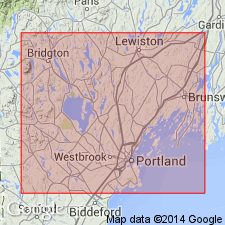
- Usage in publication:
-
- Casco Bay Group
- Modifications:
-
- Overview
- AAPG geologic province:
-
- New England province
Summary:
Casco Bay Group represents two distinct lithotectonic packages lying one to the east and one to the west of Flying Point fault. These are named respectively the Saco-Harpswell and Falmouth-Brunswick sequences. Cushing Formation, the lowermost unit of the Casco Bay is present in both sequences and is divided into 9 informal members. Those members lying west of the fault are distinctly different from those to the east. The Falmouth-Brunswick sequence (ascending) consists entirely of the Richmond Corner, Torrey Hill, Mount Ararat, and Nehumkeag Pond members of the Cushing Formation. The Saco-Harpswell sequence of the Casco Bay Group consists of the (ascending) Peaks Island, Yarmouth Island, Merepoint, Bethel Point, and Wilson Cove members of the Cushing Formation, the informal Sebascodegan formation, (rank raised), the Cape Elizabeth, Spring Point, Diamond Island, Scarboro, Spurwink, Jewell, and Macworth [Mackworth] Formations. Age of the Casco Bay is considered to be Late Proterozoic to Ordovician. [Members of the Cushing were introduced in Hussey, 1985 (Maine Open File no. 85-87), and in the present report are still considered informal by the author.]
Source: GNU records (USGS DDS-6; Reston GNULEX).
For more information, please contact Nancy Stamm, Geologic Names Committee Secretary.
Asterisk (*) indicates published by U.S. Geological Survey authors.
"No current usage" (†) implies that a name has been abandoned or has fallen into disuse. Former usage and, if known, replacement name given in parentheses ( ).
Slash (/) indicates name conflicts with nomenclatural guidelines (CSN, 1933; ACSN, 1961, 1970; NACSN, 1983, 2005, 2021). May be explained within brackets ([ ]).

